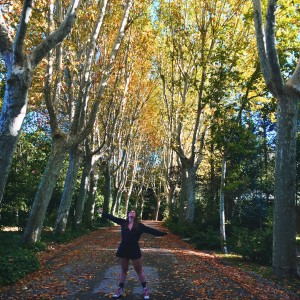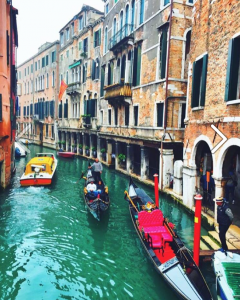Those who contemplate the beauty of the Earth find reserves of strength that will endure as long as life lasts.” (Rachel Carson)
This last month has come through like a whirlwind, and in the blink of an eye it’s all over. I just mixed metaphors, but that’s kind of how these past few weeks have gone, trying to mix together academics with the last travel endeavors and experiencing a hell-ish weird in between (I don’t think hell-ish is technically a word, but I will submit it to Webster’s right now). In this final November blog I will delve into issues that the cities I’ve travelled to exemplify, variations in conservation efforts and how that relates to the public’s opinion on natural areas, as well as reflect upon this semester and how it altered my own views and opinions over ecological issues. Okay let’s get started!
Che figata (keh fee-GAH-tah) – “What a cool thing!” in Italian
Traveling to Italy, I found nature was more incorporated in the cities we travelled to than other countries I had visited. When exploring Venice, the entire city was originally built on the Adriatic Sea. There are 177 canals with boats transporting materials and gondolas which comprise a giant chunk of the revenue from tourism (because face it- who goes to Venice and turns down a gondola ride down the Grand canal.) Since the city is mostly comprised of the canals there are actually 180+ islands created by these canals.
Saving the Sinking City
This puts the city’s current inhabitants in a tough position when it comes to modernizing. Bringing the plumbing and electricity up to date and introducing new technology is especially hard due to all places in Venice being in water. While being there multiple locals expressed concern about rising water levels; the fact of the matter is the city will be submerged completely if preventative actions aren’t taken.
Venice was born in the water, Venice was born of the water. Today as yesterday, it triumphs over the water. At least this is the destiny that Venetian history assigned to the city.” (Elisabeth Crouzet-Pavan)
In terms of species biodiversity, Italy is one of the richest countries in Europe as well as in the Mediterranean basin. It was originally estimated to comprise of about 5,500 vascular plant species. However, there are not many conservation efforts focused on maintaining species diversity. The main concern is rising sea levels that are affecting Venice; there are also a few research projects looking into how chemical disruption in the waters surrounding the country of Italy is affecting dolphins and other sea creatures. In addition to water pollution,
Italy had the world’s tenth highest level of industrial carbon dioxide emissions, which totaled 407.7 million metric tons per year, a per capita level of 7.03 metric tons.” (Nations Encyclopedia)
Architectural conservation is far more important in the eyes of the Italian government and it is apparent with complete lack of green spaces. Hopefully representatives of Italy realize how impactful climate change can be to their land, Venice especially, and implement any new more sustainable energy plans during the Climate Change Conference held this month.
After just a few short days in Venice we got on a train to Florence. One of my favorite landmarks is the Ponte Vecchio, or ‘Old Bridge’. The Ponte Vecchio joins the center of the city with the district of Oltrarno on the south bank of the river Arno. It is surely one of the great icons of Florence and one of the most famous bridges in the world. Just like Venice, Florence
Conservation Effort Variance
Italy is a historic place where natural areas are important, but not as important as conserving the historical landmarks. Spain definitely puts more value on combatting deforestation and creating a multitude of public parks to help conserve nature. However in Italy, deforestation is not a priority. Forests act as a protective barrier of the transfer of infectious diseases among humans and animals. In Spillover, David Quammen explains-
As humans have increasingly entered forests- killing and displacing macaques, cutting timber, setting fires, creating massive oil-palm plantations and small family farm plots, presenting themselves as an alternative host- both the necessity and opportunity increased.” (Quammen 2012)
Of course the breaking apart of an originally large natural space into many smaller parks is not completely ideal, but it is superior to completely eradicating an area priorly filled with trees and shrubs. Towards the end of the 20th century rates of infectious diseases according to Centers for Disease Control and Prevention lowered dramatically, which could be attributed to increase awareness and implementing of environmental acts as well as increasing medical knowledge that led to better sanitation and research into vaccines and antimicrobial drugs.
When in Rome we were bombarded with tacky tourist venues and it was obviously a city that relied almost solely on revenue from tourism. And I could not expand further on the ecological state of Rome because frankly I didn’t see much of it at all in the 24 hours we were there.
Here in Angers, we have a much larger amount of the population advocating for environmental issues such as less carbon emissions by using bikes to get around instead of cars.
We have been around for a long time, we did not begin in an industrial period; therefore, climate change is definitely top priority I would say” (First Year in France Student)
Looking into conservation efforts in France I saw that Angers has published studies in Biodiversity & Conservation; in the book Issues in Global Environment: Biodiversity, Resources, and Conservation. Angers, France also continually collaborates with Austin, Texas- another environmentally conscious city in the world. It really comes down to how passionate the inhabitants of a city are about a cause.
COP21
COP21 is a United Nations conference on climate change, beginning in 1992 it has had 20 past events where promises were made but no action was taken; this conference being the most pivotal due to our dire need for global response.
In 2015 COP21, also known as the 2015 Paris Climate Conference, will, for the first time in over 20 years of UN negotiations, aim to achieve a legally binding and universal agreement on climate, with the aim of keeping global warming below 2°C.”
Important points of discussion that will be mulled over during the week of December 3rd-11th include: Carbon Pricing & Markets- further embarking on the usage of low-carbon technologies is no longer a luxury to maybe consider, our carbon emissions are sending the world into jeopardy. Yes all this may sound dramatic or exaggerated, but statistics would beg to differ. And lack of news coverage in the U.S. has kept us in the dark about a lot of these issues. Okay, back to the topics that will be discussed and drawn upon to create an action plan:
“Exploring the role of private sector innovation and investment in developing sustainable urban environments”
“Exploring the increasing role of renewable energy technologies on low carbon development, and how new technologies and grid infrastructure can increase climate change resilience”
“Discussing innovative new processes and technologies to reduce the environmental impact of private sector operations”
Looking back upon taking the stance of Alliance of Small Island States in our class debate, I have found (even in a classroom debate) that most of the issues come from China and the United States and therefore the solutions must be enacted by those two economical powerhouses. The fact of the matter is many officials cannot agree to using completely natural energy cutting off usage of fossil fuels and/or coal because making the switch is initially costly and can be extremely disruptive in a developing community.
The costs of a pollution free society would be very high. The other extreme is to live in a society where there is no pollution control. The real world is somewhere in between these two extremes, i.e., it is necessary to achieve a balance between the social costs and social benefits of reducing pollution.” (Hopkins 1993)
Final Thoughts
The average American produces three times the amount of CO2 emissions as a person in France.” (Rosenthal 2009)
Living in France for the last three months I have seen and experienced a population that is not only more informed about environmental issues, but is provoking change at a higher scale in politics across the board. J’adore this kind of passion from a population.
If you asked me what I thought of the importance of conservation four months ago I probably would’ve responded with something alongs the line of “sure it’s important, but we should be focusing on more important economic issues”; what I failed to see at that time was that it is all interconnected. Nature conservation will help combat larger ecological issues that’s leading us to have projections in 2050 we will not be able to sustain our current life. On an individual scale that’s less terrifying, nature conservation allows for lower stress levels as well as boost in cognitive efficiency- we will literally be smarter if we keep our natural spaces around. I am so grateful for the experiences and new perspectives this semester has given me and I will no doubt be carrying them with me consciously in the coming years.
Sources Cited:
“Find out More about COP21.” UNFCCC COP 21 Paris France. N.p., n.d. Web. Dec. 2015.
Bess, Michael. The Light-Green Society: Ecology and Technological Modernity in France, 1960-2000. City of Publication: University of Chicago Press, 2003. Book.
Lieberman, Daniel. The Story of the Human Body: Evolution, Health, and Disease. N.p.: n.p., n.d. Print.
“Saving the Sinking City: Conservation Efforts in Venice, Italy.” Omeka RSS. N.p., n.d. Web. 12 Dec. 2015.
Green, Jared. “Uniting the Built & Natural Environments.” Dirt. ASLA, n.d. Web.
“Pollution Control at the Local and Global Levels.” Pollution Control at the Local and Global Levels. University of Michigan, 2001. Web. 12 Dec. 2015.
http://e360.yale.edu/feature/what_makes_europe_greener_than_the_us/2193/
“Italy – Environment.” Environment. Nations Encyclopedia, n.d. Web. 13 Dec. 2015.


